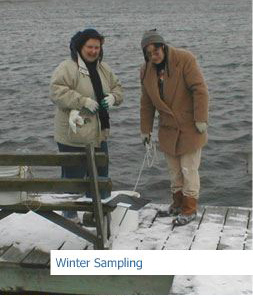Citizen Monitoring Program
2013 WATER QUALITY REPORTS AND SUMMARIES
Sept 18 - Nov 5
Here is the eighth and final set of UD Citizen Monitoring Program Reports for 2013 covering the period from Sept 18 to Nov 5, so 7 weeks.
- The first and last 3 weeks of this period were pretty dry, but a prolonged noreaster filled the 4th week with over 6in of rain. Much of the sampling for bacteria and harmful algae followed the stormy weather.
- Although most sites showed improvement during the period, Low Dissolved Oxygen readings (< 4.0 ppm) persisted in a few canals and upper tributaries. Severely low readings (< 2 ppm) were limited to 2 dead-end canal systems.
- Accumulations of Nuisance Aquatic Vegetation were limited and minor.
- Total Enterococcus Bacteria (TE) levels were elevated in a few tributaries, a stream and a bayside site, but most sites had values below the geometric mean for the season.
- In the estuaries, some minor blooms persisted before the storm, but were gone afterwards. In the ocean, Karenia papilionacea and Pseudo-nitzchia spp. were present at background cell densities. Apparently, the noreaster drove background levels of K. papilionacea into the Indian River Bay and the mouth of the Delaware Bay.
Aug 22 - Sept 19
Here is the seventh set of UD Citizen Monitoring Program Reports for 2013 covering the period from Aug 22 to Sept 19.
- The last week of August was warm and wet, but September has been cool and dry.
- Low Dissolved Oxygen readings (< 4.0 ppm) continued to be widespread, but severely low readings (< 2 ppm) were limited to a few dead-end canal systems in the Inland Bays and to Old Mill Creek in the Broadkill watershed. There was a small fish kill of 4″ Menhaden (about 140) in Russell canal, South Bethany on Sept 10 when D.O. was near zero.
- Accumulations of Nuisance Aquatic Vegetation were limited and minor.
- Total Enterococcus Bacteria (TE) levels were elevated in a few streams, tributaries, and canals, but were lower than the seasonal geometric means in most locations.
- In the estuaries, there were dense blooms of Chattonella cf. verruculosa, C. subsalsa, and other non-toxic flagellates in canal systems. In the ocean, Karenia papilionacea, Pseudo-nitzchia spp. and Dinophysis norvegica were present at background cell densities.
July 30 - Aug 22
Here is the sixth set of UD Citizen Monitoring Program Reports for 2013 covering the period from July 30 to Aug 22, so just over 3 weeks.
- Temperatures were generally moderate to cool. Rainfall was heavy in some areas during the first 2 weeks.
- Low Dissolved Oxygen readings (< 4.0 ppm) were widespread, but severely low readings (< 2 ppm) were limited to a few dead-end canal systems in the Inland Bays, and to the Petersfield ditch within the Primehook NWR.
- Accumulations of Nuisance Aquatic Vegetation generally remained limited, but a major accumulation returned to Diamond Pond after being flushed out by rain events in early August.
- Total Enterococcus Bacteria (TE) levels were lower in many locations in the second half of the period (last sample). The early August numbers are not shown due to the format of the report, but are included in the seasonal geometric means, which remain relatively high.
- In the estuaries, there was a mixed bloom of Chattonella cf. verruculosa and Heterosigma akashiwo at the Primehook boat ramp, but otherwise things were relatively quiet. The bloom of C. cf. verruculosa in South Bethany was mentioned in the previous report. In the ocean, Karenia papilionacea was consistently present at low cell densities, but one sample reached moderate cell densities at the Indian River Inlet on Aug 7. As before, Dinophysis acuminata, D. norvegica, and species of Pseudo-nitzchia and Prorocentrum were also present at low cell densities.
July 17 - 31
Here is the fifth set of UD Citizen Monitoring Program Reports for 2013 covering the period from July 17 to July 31.
- Hot, humid conditions persisted during the first week, but temperatures moderated during the second week. Rainfall was heavy in some areas, but minimal in others.
- Low Dissolved Oxygen readings (< 4.0 ppm) were widespread, however severely low readings (< 2 ppm) were limited to one stream in the Inland Bays and 2 tributaries of the Broadkill.
- Accumulations of Nuisance Aquatic Vegetation generally remained limited, but a major accumulation continued to grow in Diamond pond.
- Total Enterococcus Bacteria (TE) levels were quite elevated in many locations, including streams, ponds, upper tributaries, canals and a bayside site.
- In the estuaries, there was a bloom of Chattonella cf. verruculosa in Russell canal, South Bethany, and a bloom of mixed species at the Primehook boat ramp. In the ocean, Karenia papilionacea appeared at low densities during the second week. Also present at low densities were Dinophysis acuminata, D. norvegica, and species of Pseudo-nitzchia and Prorocentrum.
June 25 - July 18
Here is the fourth set of UD Citizen Monitoring Program Reports for 2013 covering the period from June 25 to July 18.
- Hot, humid conditions and above average rainfall continued through the period, including an extraordinary rain event on July 12 (5-10â€).
- Low Dissolved Oxygen readings (< 4.0 ppm) were widespread, however severely low readings (< 2 ppm) were limited to a few canals in the Inland Bays and 2 tributaries of the Broadkill.
- Accumulations of Nuisance Aquatic Vegetation generally remained limited, but a major accumulation returned to Diamond pond.
- Total Enterococcus Bacteria (TE) levels were quite elevated in many locations, including streams, ponds, upper tributaries and canals.
- Dense blooms of Chattonella subsalsa appeared in three separate canal systems. A dense bloom of Heterosigma akashiwo was found at the Primehook boat ramp. A dense bloom of Eutreptiella sp. (non-toxic) was noticed in the surf zone at Bethany Beach due to the green water. In other ocean samples, Dinophysis acuminata, Pseudo-nitzchia sp. and a diverse assemblage of Prorocentrum species were present at low levels.
June 12 - 26
Here is the third set of UD Citizen Monitoring Program Reports for 2013 covering the period from June 12 to June 26.
- Above average rainfall continued through the 19th, then we were fortunate to dry out a bit.
- Low Dissolved Oxygen readings (< 4.0 ppm) were widespread, however severely low readings (< 2 ppm) were limited to a few canals in South Bethany and at the Primehook NWR boat ramp.
- Accumulations of Nuisance Aquatic Vegetation were limited. Rains seemed to have flushed accumulations out of Diamond pond, but one major accumulation developed at a single site in the South Bethany canals.
- Total Enterococcus Bacteria (TE) levels were quite elevated in a few locations, including streams, ponds, upper tributaries and canals.
- Harmful algae blooms remain limited, with the exception of a localized high density bloom of Chattonella cf. verruculosa (new name on the horizon) in Russell Canal, South Bethany. Dinophysis acuminata remained at background levels in a few diverse locations. Modest bloom of Pseudo-nitzchia spp. was observed at Warwick Cove.
May 29 - June 13
Here is the second set of Citizen Monitoring Reports for 2013 covering the period May 29 to June 13.
- Rainfall was particularly heavy and frequent from June 3 on.
- Low Dissolved Oxygen readings (D.O. < 4 ppm) and severely low readings (< 2 ppm) became more widespread. DO in several dead-end canals in South Bethany canals exhibited an interesting rebound in the second week.
- Accumulations of Nuisance Aquatic Vegetation decreased, particularly for seaweeds in the estuaries.
- Total Enterococcus Bacteria (TE) levels were quite elevated in a few locations, including streams, ponds, upper tributaries and canals.
- Harmful algae blooms were limited to isolated, moderate density blooms of Chattonella cf. verruculosa and Heterosigma akashiwo. Dinophysis acuminata was a background levels at the Indian River and Roosevelt Inlets and in Torquay canal.
April - May
Here is the first set of Citizen Monitoring Reports for 2013 covering the months of April and May. Subsequent reports will follow every 2 weeks or so during the summer.
- Low Dissolved Oxygen readings (< 4 ppm) were detected at many sites in upper tributaries and residential canals, particularly in May. However, severely low readings (< 2 ppm) were limited to one observation at the Prime Hook Boat ramp.
- Minor accumulations of Nuisance Aquatic vegetation were widespread, but major accumulations were limited to a few sites including the Petersfield ditch in Prime Hook NWR, and some canals in the Inland Bays.
- Total Enterococcus (TE) levels were elevated in a few fresh water streams, a few upper tributaries, and in a few canals.
- A variety of Harmful Algae were present throughout the area at low cell densities. Blooms of a few non-toxic algae reached high cell densities. Blooms of a few potentially toxic algae that may harm aquatic organisms (Prorocentrum, Karlodinium, Heterosigma) were below thresholds of concern. Dinophysis acuminata, a species of concern for shellfish toxicity, was observed at relatively high cell densities in Torquay canal, which is outside of approved shellfish harvesting areas.



Copyright © 2016 University of Delaware College of Earth, Ocean, and Environment and the Delaware Sea Grant College Program | 302-645-4252


